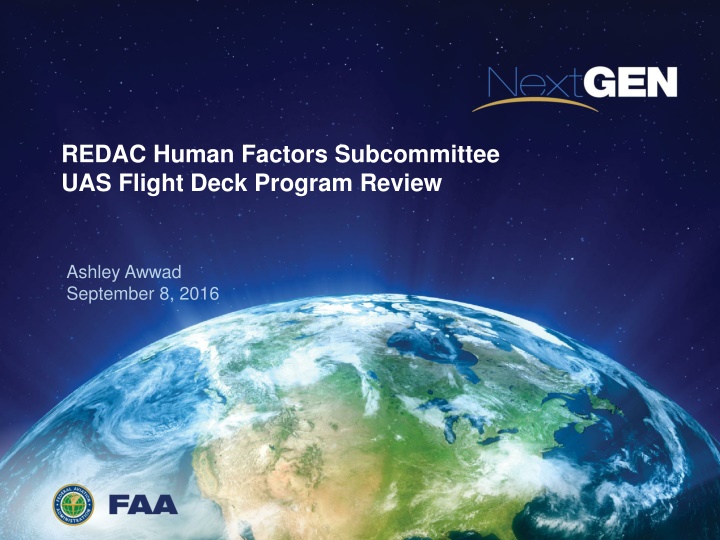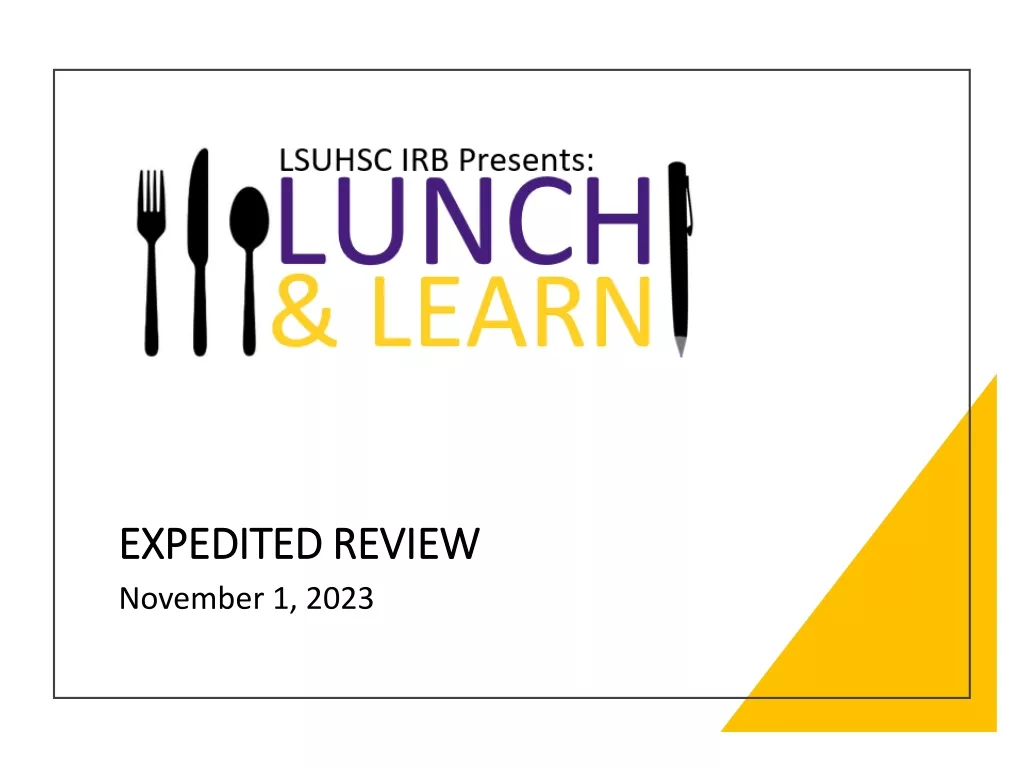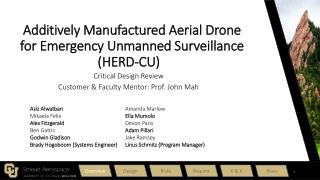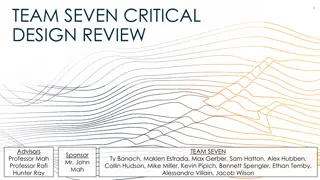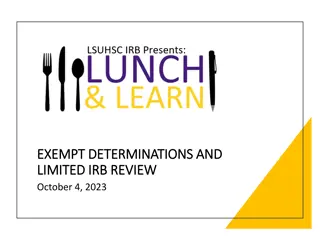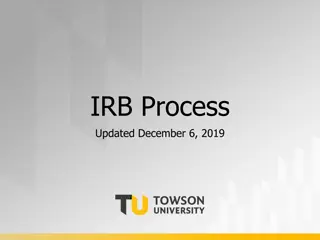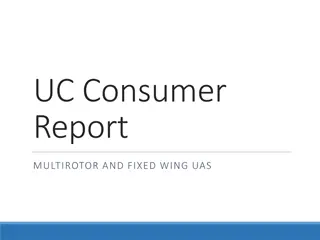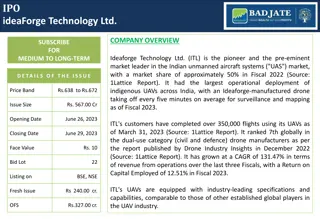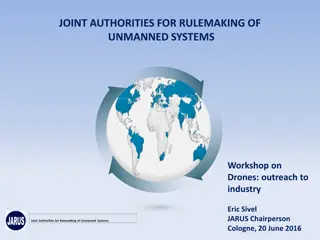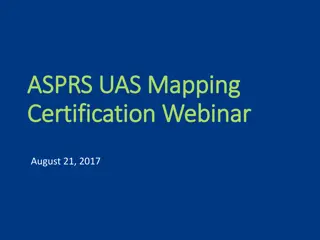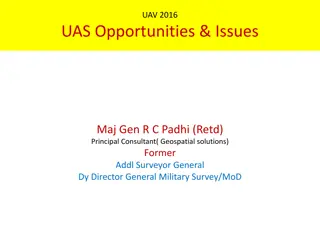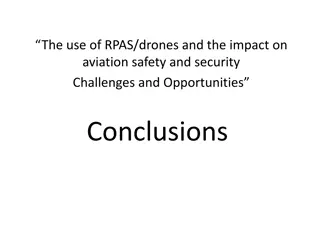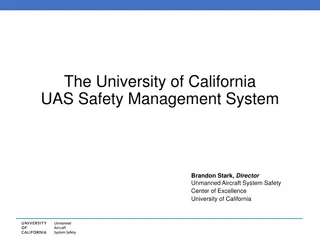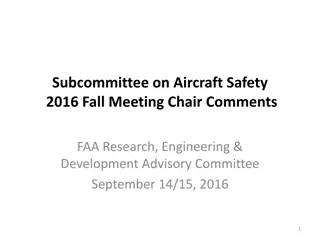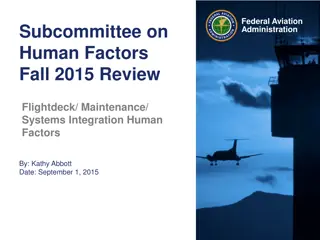UAS Human Factors Research Review
Research review on UAS human factors including Flight Deck program, Minimum Detect and Avoid (DAA), display information, and assessment for en-route contingency operations sponsored by the Federal Aviation Administration. Critical milestones, accomplishments, and future goals highlighted for integrating UAS into the National Airspace System as part of NextGen.
Download Presentation

Please find below an Image/Link to download the presentation.
The content on the website is provided AS IS for your information and personal use only. It may not be sold, licensed, or shared on other websites without obtaining consent from the author.If you encounter any issues during the download, it is possible that the publisher has removed the file from their server.
You are allowed to download the files provided on this website for personal or commercial use, subject to the condition that they are used lawfully. All files are the property of their respective owners.
The content on the website is provided AS IS for your information and personal use only. It may not be sold, licensed, or shared on other websites without obtaining consent from the author.
E N D
Presentation Transcript
REDAC Human Factors Subcommittee UAS Flight Deck Program Review Ashley Awwad September 8, 2016 Federal Aviation Administration
3 Human Factors UAS Research Human Factors UAS Research TCRG research requirement areas: Flight Deck Human Factors Research Requirement Area Aviation Safety (AVS) Principal Technical Sponsor Minimum Detect and Avoid (DAA) Display and Flight Path Information Flight Standards - Unmanned Aircraft Systems (AFS-86) UAS Assessment for Enroute Contingency Operations Air Traffic Procedures (AJV-8) UAS Human Factors Consideration Flight Standards - Unmanned Aircraft Systems (AFS-86) Federal Aviation Administration FY16 Human Factors REDAC Fall Meeting 2
MINIMUM DETECT AND AVOID (DAA) MINIMUM DETECT AND AVOID (DAA) DISPLAY AND FLIGHT PATH DISPLAY AND FLIGHT PATH INFORMATION INFORMATION Federal Aviation Administration FY16 Human Factors REDAC Fall Meeting 3
075 +09 NextGen: Minimum Detect and Avoid (DAA) Display and Flight NextGen: Minimum Detect and Avoid (DAA) Display and Flight Path Information Path Information (A12C.HFNG.1) (A12C.HFNG.1) UAL 455 +16 -09 +10 5 nm ResearchRequirement Description +26 Sponsor Outcome -25 Determine the minimum necessary DAA display information required for a UAS pilot to remain well clear. DAA is necessary for integration of UAS in the NAS as part of NextGen. Regulatory standards for the display of detect and avoid information Sponsor: Stephen Plishka (AFS-86) Critical Milestones Research Accomplishments in FY16 Literature review and related recommendations for DAA. (FY16) Completed quick-look report documenting the findings from initial simulations for UAS Detect and Avoid Final technical report describing the results to support minimum requirements for DAA (FY17) Federal Aviation Administration FY16 Human Factors REDAC Fall Meeting 4
UAS ASSESSMENT FOR UAS ASSESSMENT FOR EN CONTINGENCY OPERATIONS CONTINGENCY OPERATIONS EN ROUTE ROUTE Federal Aviation Administration FY16 Human Factors REDAC Fall Meeting 5
UAS Assessment for En Route Contingency Operations Research Requirement Description Sponsor Outcome Mitigation of the impact of UAS en route contingency operations. A literature review and user needs analysis will be conducted and used to develop a study plan to investigate potential procedures and technological solutions to mitigate the workload and safety impact of UAS contingency operations (such as loss of control link). From an ATC perspective, it is critical that the UAS behaves in a predictable manner and is compatible with manned aircraft operations. However, there are unique needs of UAS operations that arise during various contingency conditions, for example, the need to reacquire a lost control link. Research plan to test controller and pilot performance with procedures and technology to mitigate the effects of contingency operations in a human-in-the-loop simulation. Sponsor: Brett Steffey (AJV-8) Other stakeholders: AFS-86, AJV-7, AJC-115, NATCA Critical Milestones Research Accomplishments in FY16 Literature review and baseline of current Procedures Complete Delivered literature review Site visits to Los Angeles, Minneapolis, and Chicago ARTCCs and Joshua TRACON to conduct knowledge elicitation interviews with controllers on current UAS lost link, lost comm, & other contingencies and explore procedures and technological enhancements to mitigate the impact of contingency operations Knowledge elicitation interviews with Reaper & Global Hawk pilots regarding contingency operations and flight replanning capabilities SME interviews (ATC and UAS pilots) 12/31/16 Candidate procedures and technologies for mitigating effects of contingencies 4/30/17 Test plan for evaluating candidate procedures/technologies 6/30/17 Report documenting: 1) results of literature review and baseline of current procedures (e.g., lost link); 2) data collected from SME interviews (ATC and UAS pilots); 3) list of possible solutions (candidate procedures and technologies); 4) test plan for evaluating candidate procedures/technologies 6/30/17 Federal Aviation Administration FY16 Human Factors REDAC Fall Meeting 6
UNMANNED AIRCRAFT SYSTEMS UNMANNED AIRCRAFT SYSTEMS HUMAN FACTORS CONSIDERATIONS HUMAN FACTORS CONSIDERATIONS Federal Aviation Administration FY16 Human Factors REDAC Fall Meeting 7
UAS Human Factors Control Station Design Standards Research Requirement Description Sponsor Outcome Develop appropriate function allocation strategy for civil UAS based on human factors principles and research Based on the function allocation strategy, develop recommended control station standards and guidelines Develop recommended crewmember training and certification requirements for pilots and other crewmembers Through ethnographic research, recommend visual observer training and certification requirements Empirical research to support the development of the new standards needed for control station design, for operator training and certification, and for visual observer operations. Sponsor: Stephen Plishka, AFS-86 Critical Milestones Research Accomplishments in FY16 Delivered literature review on human factors research related to function allocation strategies for UAS human-automation functions Delivered literature review on the human factors research related to UAS mission planning Develop recommended function allocation strategies for UAS human-machine functions Jan 2017 Develop recommended minimum standards and design guidelines for UAS control stations July 2017 Develop recommended crewmember training and certification requirements, to include pilots and other crew members Dec 2017 Develop recommended visual observer training and certification requirements to support the safe integration of UAS in the NAS May 2017 Federal Aviation Administration FY16 Human Factors REDAC Fall Meeting 8
BACKUP/PREVIOUS BACKUP/PREVIOUS Federal Aviation Administration FY16 Human Factors REDAC Fall Meeting 9
MINIMUM DETECT AND AVOID (DAA) MINIMUM DETECT AND AVOID (DAA) DISPLAY AND FLIGHT PATH DISPLAY AND FLIGHT PATH INFORMATION INFORMATION Federal Aviation Administration FY16 Human Factors REDAC Fall Meeting 10
075 +09 UAS Minimum Detect and Avoid Display & Flight Path Information UAL 455 +16 -09 +10 5 nm Research Requirement Description Sponsor Outcome +26 -25 The FAA s Unmanned Aircraft Systems (UAS) Program Office requested a study that would provide scientific data to inform development of regulatory and guidance materials for Aircraft Certification of UAS control stations, specifically, to establishing the minimum requirements for approving detect and avoid (DAA) system displays that are necessary to allow a UAS pilot to remain well-clear of other aircraft. The data support development of regulatory and guidance material that addresses traffic Information, alerting, and flight path guidance to provide adequate UAS pilot performance. These data will be used by RTCA SC-228 for the Minimal Operational Performance Standards for DAA. Empirical basis for display and alerting requirements in RTCA SC-228 minimum operational performance standard for UAS detect and avoid systems. Sponsor: Stephen Plishka, AFS-86 Critical Milestones Research Accomplishments in FY16 Completed initial simulations for UAS Detect and Avoid March 2016 Completed initial data analysis Completed quick-look on initial study findings Run simulation for UAS Detect and Avoid (WJHTC) Complete Technical Report on minimum DAA display requirements, alerting requirements, and human interface recommendations (CAMI) 12/31/2016 Run full mission simulations using recommended displays 09/30/2017 Report documenting the results of full mission simulations 09/30/2017 Federal Aviation Administration FY16 Human Factors REDAC Fall Meeting 11
UAS ASSESSMENT FOR UAS ASSESSMENT FOR EN CONTINGENCY OPERATIONS CONTINGENCY OPERATIONS EN ROUTE ROUTE Federal Aviation Administration FY16 Human Factors REDAC Fall Meeting 12
UAS Assessment for En Route Contingency Operations Research Requirement Description Sponsor Outcome Mitigation of the impact of UAS en route contingency operations. A literature review and user needs analysis will be conducted and used to develop a study plan to investigate potential procedures and technological solutions to mitigate the workload and safety impact of UAS contingency operations (such as loss of control link). From an ATC perspective, it is critical that the UAS behaves in a predictable manner and is compatible with manned aircraft operations. However, there are unique needs of UAS operations that arise during various contingency conditions, for example, the need to reacquire a lost control link. Research plan to test controller and pilot performance with procedures and technology to mitigate the effects of contingency operations in a human-in-the-loop simulation. Sponsor: Brett Steffey (AJV-8) Other stakeholders: AFS-86, AJV-7, AJC-115, NATCA Critical Milestones Research Accomplishments in FY16 Literature review and baseline of current Procedures Complete Delivered literature review Site visits to Los Angeles, Minneapolis, and Chicago ARTCCs and Joshua TRACON to conduct knowledge elicitation interviews with controllers on current UAS lost link, lost comm, & other contingencies and explore procedures and technological enhancements to mitigate the impact of contingency operations Knowledge elicitation interviews with Reaper & Global Hawk pilots regarding contingency operations and flight replanning capabilities SME interviews (ATC and UAS pilots) 12/31/16 Candidate procedures and technologies for mitigating effects of contingencies 4/30/17 Test plan for evaluating candidate procedures/technologies 6/30/17 Report documenting: 1) results of literature review and baseline of current procedures (e.g., lost link); 2) data collected from SME interviews (ATC and UAS pilots); 3) list of possible solutions (candidate procedures and technologies); 4) test plan for evaluating candidate procedures/technologies 6/30/17 Federal Aviation Administration FY16 Human Factors REDAC Fall Meeting 13
UNMANNED AIRCRAFT SYSTEMS UNMANNED AIRCRAFT SYSTEMS HUMAN FACTORS CONSIDERATIONS HUMAN FACTORS CONSIDERATIONS Federal Aviation Administration FY16 Human Factors REDAC Fall Meeting 14
UAS Human Factors Control Station Design Standards Research Requirement Description Sponsor Outcome Develop appropriate function allocation strategy for civil UAS based on human factors principles and research Based on the function allocation strategy, develop recommended control station standards and guidelines Develop recommended crewmember training and certification requirements for pilots and other crewmembers Through ethnographic research, recommend visual observer training and certification requirements Empirical research to support the development of the new standards needed for control station design, for operator training and certification, and for visual observer operations. Sponsor: Stephen Plishka, AFS-86 Critical Milestones Research Accomplishments in FY16 Delivered literature review on human factors research related to function allocation strategies for UAS human-automation functions Develop recommended function allocation strategies for UAS human-machine functions Jan 2017 Develop recommended minimum standards and design guidelines for UAS control stations July 2017 Develop recommended crewmember training and certification requirements, to include pilots and other crew members Dec 2017 Develop recommended visual observer training and certification requirements to support the safe integration of UAS in the NAS May 2017 Federal Aviation Administration FY16 Human Factors REDAC Fall Meeting 15
